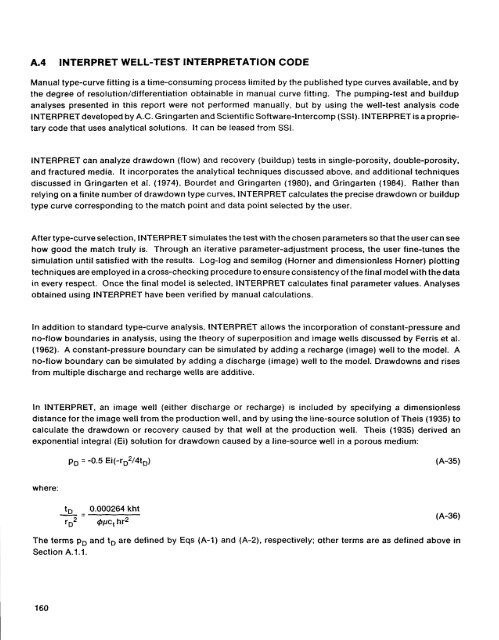Beauheim 1987 - Waste Isolation Pilot Plant - U.S. Department of ...
Beauheim 1987 - Waste Isolation Pilot Plant - U.S. Department of ...
Beauheim 1987 - Waste Isolation Pilot Plant - U.S. Department of ...
Create successful ePaper yourself
Turn your PDF publications into a flip-book with our unique Google optimized e-Paper software.
A.4 INTERPRET WELL-TEST INTERPRETATION CODE<br />
Manual type-curve fitting is a time-consuming process limited by the published type curves available, and by<br />
the degree <strong>of</strong> resolution/differentiation obtainable in manual curve fitting. The pumping-test and buildup<br />
analyses presented in this report were not performed manually, but by using the well-test analysis code<br />
INTERPRET developed by A.C. Gringarten and Scientific S<strong>of</strong>tware-lntercomp (SSI). INTERPRET is a proprietary<br />
code that uses analytical solutions. It can be leased from SSI.<br />
INTERPRET can analyze drawdown (flow) and recovery (buildup) tests in single-porosity, double-porosity,<br />
and fractured media. It incorporates the analytical techniques discussed above, and additional techniques<br />
discussed in Gringarten et al. (1974). Bourdet and Gringarten (1980). and Gringarten (1984). Rather than<br />
relying on a finite number <strong>of</strong> drawdown type curves, INTERPRET calculates the precise drawdown or buildup<br />
type curve corresponding to the match point and data point selected by the user.<br />
After type-curve selection, INTERPRET simulates the test with the chosen parameters so that the user can see<br />
how good the match truly is. Through an iterative parameter-adjustment process, the user fine-tunes the<br />
simulation until satisfied with the results. Log-log and semilog (Horner and dimensionless Horner) plotting<br />
techniques are employed in a cross-checking procedure to ensure consistency <strong>of</strong> the final model with the data<br />
in every respect. Once the final model is selected, INTERPRET calculates final parameter values. Analyses<br />
obtained using INTERPRET have been verified by manual calculations.<br />
In addition to standard type-curve analysis, INTERPRET allows the incorporation <strong>of</strong> constant-pressure and<br />
no-flow boundaries in analysis, using the theory <strong>of</strong> superposition and image wells discussed by Ferris et al.<br />
(1962). A constant-pressure boundary can be simulated by adding a recharge (image) well to the model. A<br />
no-flow boundary can be simulated by adding a discharge (image) well to the model. Drawdowns and rises<br />
from multiple discharge and recharge wells are additive.<br />
In INTERPRET, an image well (either discharge or recharge) is included by specifying a dimensionless<br />
distance for the image well from the production well, and by using the line-source solution <strong>of</strong> Theis (1935) to<br />
calculate the drawdown or recovery caused by that well at the production well. Theis (1935) derived an<br />
exponential integral (Ei) solution for drawdown caused by a line-source well in a porous medium:<br />
po = -0.5 Ei(-rD2/4tD)<br />
(A-35)<br />
where:<br />
= 0.000264 kht<br />
-<br />
(A-36)<br />
rD2 @pc,hr2<br />
The terms pD and tD are defined by Eqs (A-1) and (A-2), respectively; other terms are as defined above in<br />
Section A.l.l.

















